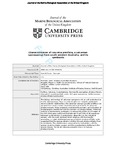Characterization of Leucetta prolifera, a calcarean cyanosponge from south-western Australia, and its symbionts
| dc.contributor.author | Fromont, J | |
| dc.contributor.author | Huggett, MJ | |
| dc.contributor.author | Lengger, Sabine | |
| dc.contributor.author | Grice, K | |
| dc.contributor.author | Schönberg, CHL | |
| dc.date.accessioned | 2015-11-09T12:51:39Z | |
| dc.date.available | 2015-11-09T12:51:39Z | |
| dc.date.issued | 2015-09-08 | |
| dc.identifier.issn | 0025-3154 | |
| dc.identifier.issn | 1469-7769 | |
| dc.identifier.uri | http://hdl.handle.net/10026.1/3772 | |
| dc.description.abstract |
The biology and ecology of calcarean sponges are not as well understood as they are for demosponges. Here, in order to gain new insights, particularly about symbiotic relationships, the calcarean sponge <jats:italic>Leucetta prolifera</jats:italic> was sampled from south-western Australia and examined for its assumed photosymbionts. Pulse amplitude modulated fluorometry and extraction of photopigments established that the sponge was photosynthetic. Molecular analysis of the bacterial symbionts via sequencing of the V1–V3 region of the 16S rDNA gene confirmed that between 5 and 22% of all sequences belonged to the phylum Cyanobacteria, depending on the individual sample, with the most dominant strain aligning with <jats:italic>Hormoscilla spongeliae</jats:italic>, a widely distributed sponge symbiont. Analysis of fatty acids suggested that the sponge obtains nutrition through photosynthates from its symbionts. The relationship is assumed to be mutualistic, with the sponge receiving dietary support and the cyanobacteria sheltering in the sponge tissues. We list all Calcarea presently known to harbour photosymbionts. | |
| dc.format.extent | 1-12 | |
| dc.language | en | |
| dc.language.iso | en | |
| dc.publisher | Cambridge University Press (CUP) | |
| dc.subject | Porifera | |
| dc.subject | Calcarea | |
| dc.subject | Cyanobacteria | |
| dc.subject | Hormoscilla spongeliae | |
| dc.subject | photosymbiosis | |
| dc.subject | chlorophyll | |
| dc.subject | 16S gene sequencing | |
| dc.subject | membrane fatty acids | |
| dc.subject | stable isotopes | |
| dc.subject | photosynthate translocation | |
| dc.title | Characterization of Leucetta prolifera, a calcarean cyanosponge from south-western Australia, and its symbionts | |
| dc.type | journal-article | |
| dc.type | Article | |
| plymouth.author-url | https://www.webofscience.com/api/gateway?GWVersion=2&SrcApp=PARTNER_APP&SrcAuth=LinksAMR&KeyUT=WOS:000371163700028&DestLinkType=FullRecord&DestApp=ALL_WOS&UsrCustomerID=11bb513d99f797142bcfeffcc58ea008 | |
| plymouth.issue | 2 | |
| plymouth.volume | 96 | |
| plymouth.publication-status | Published | |
| plymouth.journal | Journal of the Marine Biological Association of the United Kingdom | |
| dc.identifier.doi | 10.1017/S0025315415000491 | |
| plymouth.organisational-group | /Plymouth | |
| plymouth.organisational-group | /Plymouth/Faculty of Science and Engineering | |
| plymouth.organisational-group | /Plymouth/REF 2021 Researchers by UoA | |
| plymouth.organisational-group | /Plymouth/REF 2021 Researchers by UoA/UoA07 Earth Systems and Environmental Sciences | |
| dcterms.dateAccepted | 2015-03-29 | |
| dc.identifier.eissn | 1469-7769 | |
| dc.rights.embargoperiod | Not known | |
| rioxxterms.versionofrecord | 10.1017/S0025315415000491 | |
| rioxxterms.licenseref.uri | http://www.rioxx.net/licenses/all-rights-reserved | |
| rioxxterms.licenseref.startdate | 2015-09-08 | |
| rioxxterms.type | Journal Article/Review |


